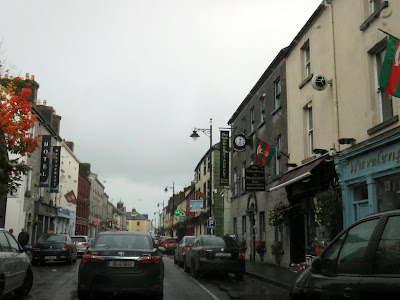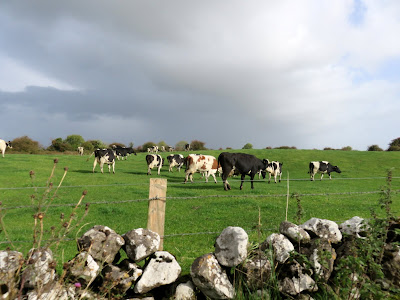We were a
little down as this was our last day in Ireland before flying home to the
USA. Still, I was determined to get as
much out of the day as possible and that was challenging because it rained hard
off and on during our drive.
When we
left our bed and breakfast in Cong, I headed north and a little east on R345
and R334 to the village of Ballinrobe.
In Irish Gaelic, it’s Baile an
Roba, meaning “town of the (river) Robe”.
Ballinrobe
dates back to 1390 and it’s reputed to be the oldest town in County Mayo. In 1606, King James granted the town a Royal
Patent which allowed the town to hold fairs and markets. Obtaining a market charter was an important
step in the economic development of a town.
Today, Ballinrobe has about 3,700 residents.
Every now
and then we were rewarded with a burst of sunshine…and we took the opportunity
to take this photo of these colorful flowers.
Ireland
provided workhouses during the potato famine under the country’s Poor Laws. Ballinrobe suffered greatly during the Great
Famine of 1845 – 1849. At the height of
the famine, the vastly overcrowded workhouse/poorhouse was jammed…with 2,000
inmates! To quote The Mayo Constitution, “…the workhouse is in the most awfully
deplorable state, pestilence attacking paupers, officers and all. In fact, this building is one horrible
charnel house, the unfortunate paupers being nearly all the victims of a
fearful fever, the dying and the dead, we might say, huddled together.” During just 1 week in April of 1849, 96
people died in this workhouse…
If you
needed proof that we stayed on the back roads in an effort to see as much of the
Irish countryside as possible, this cow ‘roadblock’ should provide enough
evidence to support my claim! Of course,
the road wasn’t exactly a superhighway…narrow at best.
After a
few minutes of following the cows and the farmer up the road, he directed them
into a lush field… The experience for the cows and the people grew a touch more
‘interesting’ when we encountered a truck coming the other way. The cows squeezed by on one side…and all was
well.
From
Ballinrobe, I’d followed a series of country roads almost due east. After a bit we came to the village of
Ballindine. The Irish post offices in
these small towns and villages are quaint and the green really stands out.
In Irish
Gaelic, Baile an Daighim, means “Town
of the Fortress. The remains of a
possible fort are located in a field next to the school. Folklore states that the town got its name
from this ancient fort.
…yet
another burst of sunshine showing off the Irish countryside. In this part of west central Ireland, mountains
and major hills give way to a pastoral look, pleasant but not dramatic.
We just
had to take a photo of these ruins. I
wonder about the stories that these old stone walls could tell! I’m not sure if it was a home or some kind of
business back in the day…
Shortly
after passing the ruins shown in the previous photo, we noted this dilapidated
tower castle near the town of Dunmore.
Located on a small hillock, the first castle
on this site was built by the Anglo-Norman de-Birmingham family so they could
defend themselves (not always successfully) from area native Irish forces. After a last assault in 1315, the castle was
largely rebuilt. Much of the current
structure dates from the early 1300s. It
is accessible to the general public.
Then we
found ourselves driving though Dunmore itself.
This street was a tad bit narrow, don’t you think!?
The area
around Dunmore came under the rule of Ui
Conchobair in the 1100s. For a
period of time, it was the capital of the King of Connacht, Tairrdelbach Ua Conchobair who died here
in 1156. Tairrdelbach, (Anglicized O’Conor or O’Connor), was King for 50
years! He dominated Irish politics and
led armies and navies all over the island subjugating entire kingdoms. At the battle of Moin Mor in 1151 his forces inflicted 7,000 enemy casualties…
Laurie
took this photo just to show a picture of a nice little home in the Irish
countryside…
This is a
nice partially sunny view along our backroad route toward Dublin. The countryside was still very appealing if
not as dramatic as in the west of Ireland.
We
continued on passing through the villages of Glennamaddy, Creggs and Athleague
along the way. Some of the small
villages were obviously in decline…something we didn’t see in the tourist
focused areas. Farming is tough
everywhere…
Creggs is
also known as Costa Brava. Even though
it only has a population of around 100, it has 3 public houses/bars. It used to have 7!
This is
the Old Church of Ireland in Athleague County Roscommon. This old stone church is surrounded by stone
walls. It was built in 1841 but from
what I’ve read, these days the handsome old church is the home of the River
Suck Athleague Angling Center.
The
sunshine stayed with us…and then we entered the big town of Roscommon.
At the time, if I’d spotted Molloy’s Bakery
and Fine Food Emporium, (orange building), we would have come to a screeching halt! We love a good bakery…a little too much. They bake 21 different types of bread and rolls
and they serve food too! Molloy’s has
been in business for 96 years as of this year!
Check out their website at http://molloysbakery.ie/.
We
spotted a big church or cathedral in the distance so we circled the area in an
effort to gain access. Like most towns
in Ireland or Scotland, the streets wander in all direction…straightforward street
grids just don’t occur!
My
efforts to locate the church paid off…for Laurie. She was out of the car with our camera and talking
to these horses ASAP. She got an instant
‘horse fix’!
Some of
the horses were a bit standoffish but she did make a friend with this one. If only she had some sugar cubes in her
pocket!
This very
large and impressive house of worship is the Sacred Heart Catholic Church in the town of Roscommon. This parish has 1,500
families, 5 priests and 2 deacons! This parish church was built in 1903 with the
tower being added in 1916.
The architectural
design of this church is referred to as being ‘flamboyant’. I’d never heard of ‘flamboyant’ as a design
style so I had to look it up. It was the
name given to a florid style of late Gothic architecture that was popular in
France from about 1350 until it was superseded by Renaissance architecture in
the early 1500s.
To match
the flamboyant style of the rest of the exterior of this church, the freeze
over the front doors of Sacred Heart is both impressive and beautiful. The interior of this big church is pretty
stunning too. If you’re interested in
seeing more, you can check out some terrific photos at http://www.sacredheartroscommon.com/gallery/.
Just
click on any of the photos to enlarge them…
Thanks
for stopping by for a visit… FYI, my next post from Ireland will be the
last.
Take
Care, Big Daddy Dave

















No comments:
Post a Comment